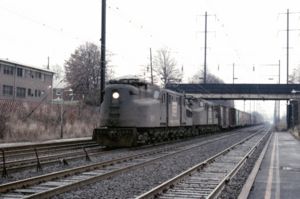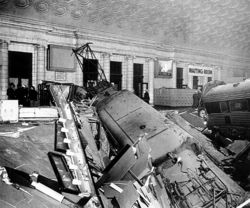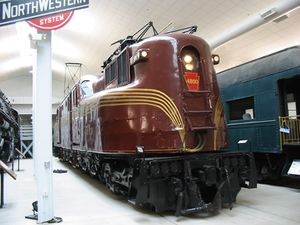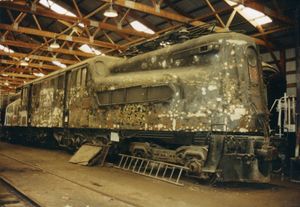PRR GG1
| PRR GG1 Amtrak #928, a former PRR GG1, speeds through North Elizabeth, New Jersey in December, 1975 | |
| Power type | Straight electric |
|---|---|
| Designer | Raymond Loewy |
| Build date | 1934 – 1943 |
| Total production | 139 |
| AAR wheel arr. | 2-C+C-2 |
| Gauge | 4 ft 8½ in (1435 mm) |
| Length | 79 ft 6 in (24.23 m) |
| Total weight | 477,000 lb (216,000 kg) |
| Electric system | 11,000 V AC, 25 Hz |
| Collection method | dual pantograph |
| Engine type | quill drive |
| Top speed | 100 mph (160 km/h) (passenger) 90 mph (144 km/h) (freight) |
| Power output | 4,620 hp (3,660 kW) |
| Tractive effort | 70,700 lbf (314 kN) |
| Career | Pennsylvania Railroad, Penn Central, Conrail, Amtrak, New Jersey Transit |
| Class | GG1 |
| Locale | Northeast United States |
| Disposition | most scrapped, several preserved in static display around the U.S. |
The Pennsylvania Railroad's GG1 class of electric locomotives were built between 1934 to 1943 at the PRR shops in Altoona, Pennsylvania, with a total of 139 units constructed. They remained in service with the PRR's successors until the early 1980s. The GG1 became one of the most recognized and famous classes of locomotive worldwide.
Contents
Technical information
The GG1s were large locomotives, 79 ft 6 in (24.23 m) long and weighing 477,000 lb (216,000 kg). The main body was a single unit formed as a bridge-truss framework and clad in welded steel plate. The driving cabs were set up high about a third of the way along the locomotive from each end for greater crew safety in an accident. A narrower section of nose in front of the cab windows was lowered to enabled view forward, although the nose remained full height to carry the current-collection pantographs. The bodywork as a whole was smoothly rounded.
This was mounted upon two great cast steel locomotive frames linked by a hinge at the locomotive's middle which allowed side-to-side movement. Six driving wheels (three axles) were fitted towards the center of the locomotive on each truck (twelve in total) and a four-wheeled, unpowered guiding truck was mounted toward each end. In the Whyte notation for steam locomotives, each frame comprised a 4-6-0 locomotive; in the PRR's classification system, 4-6-0s were class "G". The GG1 consisted of two such locomotive frames mounted back to back, so it was classified GG—4-6-0+0-6-4. This arrangement is called 2-C+C-2 in AAR wheel arrangement notation. Each driven axle was powered by two 385 hp (305 kW) GEA-627-A1 traction motors mounted above and to either side of the axle. Drive was through a reduction gear and a quill drive assembly.
While the famous industrial designer Raymond Loewy did not design the shape of the GG1 electric locomotives, he did improve their looks by recommending a smooth welded construction be used (rather than riveted construction), along with a pinstriped paint scheme to highlight their smoothly rounded forms. The real design behind the GG1 came from the New Haven Railroad EP3 electric. The New Haven allowed the PRR to borrow a pair of EP3s for testing, and the PRR was quite impressed with their performance and decided to base the design of its electric locomotive on the EP3.[citation needed]
The GG1 was designed to run on the standard Pennsylvania Railroad catenary power of 11,000 V AC, 25 Hz. This high voltage was stepped down by a large transformer mounted in the center of the locomotive body for the traction motors, cooling blowers and all other onboard equipment. The locomotive's power was controlled via a tap-switching arrangement; the number of secondary windings in use could be varied, thus adjusting the output voltage. The units were rated at 4,620 hp (385 hp per motor) continuous rating and a maximum of 9,500 hp at 49 mph (intermittent duty). For passenger service, the GG1 was geared to run at 100 mph maximum although it achieved 110 mph in testing. For freight service, the locomotive was geared to run at 90 mph maximum.
History
A GG1 crash
One of the more interesting moments in the history of the GG1 locomotive took place on the morning of January 15 1953 at Washington's Union Station. Due to a brake line cock (valve) that closed due to poor location (its location caused the valve to close due to contact with the bottom cross member of the car), the Federal Express from Boston was unable to apply the brakes on part of the train. Pushed by the unbraked cars, the GG1 engine (#4876) and two passenger cars ran off the end of Track 16 and crashed through the floor of Union Station and into the baggage room. With President Eisenhower's inauguration in days, the cars were hauled out by the next day. The GG1 was left in the basement under a temporary flooring. After the inauguration, in a remarkable demonstration of the durability of the GG1 engines, Engine #4876 was later cut into three pieces, removed from the baggage room, and reassembled at the Altoona (PA) shops of the Pennsylvania Railroad. It then re-entered commercial service and went on to be one of the last-serving GG1 engines. As of August 2006 it is owned by the Baltimore & Ohio Railroad Museum in Baltimore, Maryland. Currently, it has fallen into disrepair, and it isn't as well kept as sister 4877 (Which has recently had its door stolen).
Disposition
While it is widely believed that the GG1s were retired due to a change in the electric power supply on the former PRR electrified zone, other concerns led to the retirement of the GG1s. Aside from maintenance and performance issues, the nail in the GG1's coffin was an ever growing problem with frame cracks which were expensive to repair and occurring more and more frequently. Amtrak's first attempt to replace the GG1, the E60, did not live up to expectations. Amtrak's purchase of AEM-7 electric locomotives allowed it to retire its fleet of GG1s. With the AEM-7s on hand Amtrak was not only able to replace its own GG1s, but sell a number of E60s to New Jersey Transit to replace their GG1s operating commuter trains on the North Jersey Coast Line (all E60s have since been retired by both Amtrak and NJT, with both agencies using AEM-7 or ALP-44 locomotives, with Amtrak augmenting its AEM-7 fleet with HHP-8 locomotives and NJT purchasing ALP-46 locomotives).
It has often been proposed for a GG1 to be restored to operating condition. While it would be theoretically possible to run a GG1 on the current Northeast Corridor's electrical system, all surviving GG1s contain large amounts of toxic PCBs in their electrical systems as well as asbestos. These put a restoration far out of reach for most non-profit preservation groups.
Surviving examples
- PRR 4800 — Railroad Museum of Pennsylvania, Strasburg, PA (a.k.a. "Old Rivets" — the prototype GG1 and was the only GG1 that had a riveted body; was formerly painted in Bicentennial colors and was the only GG1 to receive Conrail blue).
- PRR 4859 — Transportation Center, Harrisburg, PA (designated as official electric locomotive of PA in 1938).
- PRR 4876 — B&O Railroad Museum, Baltimore, MD (as of Spring 2006, in rapidly deteriorating condition); the GG1 was languishing in a CSX Yard south of downtown Baltimore (seen from Interstate 95 northbound between Washington Boulevard and Maryland 295), but as of summer 2006 has been moved back onto museum property. Restoration plans are unknown.
- PRR 4877 — New Jersey Transit yard, Morristown, NJ. Currently undergoing renovations at Lebanon Station (Raritan Valley Line).
- PRR 4879 — URHS of NJ.
- PRR 4882 — New York Central Railroad Museum, Elkhart, IN (currently painted as Penn Central 4882)
- PRR 4890 — National Railroad Museum, Green Bay, WI.
- PRR 4903/Amtrak 4906 — Museum of the American Railroad, Dallas, TX (pulled Robert Kennedy's funeral train along with GG1 4901 from New York to Washington on June 8 1968).
- PRR 4909/Amtrak 4932 — Cooperstown Junction, NY (arguably the most confused ownershipped surviving GG1; cited and/or supposed owners have ranged from Steamtown National Historic Site to the Henry Ford Museum).
- PRR 4913/Amtrak 4913 — Railroader's Memorial Museum, Altoona, PA.
- PRR 4917/Amtrak 4934 — Leatherstocking RY Museum, Cooperstown Jct, NY (one of 75 GG1s built with Westinghouse components, the other 64 GG1s used GE devices and motors).
- PRR 4918/Amtrak 4916 — Museum of Transportation, St. Louis, MO (was once the property of the Smithsonian Institute).
- PRR 4919/Amtrak 4917 — VA Museum of Transportation, Roanoke, VA.
- PRR 4927/Amtrak 4939 — Illinois Railway Museum, Union, IL (Amtrak's renumbering in 1976 to 4939 bucked 42 years of numbering by making it the highest numbered GG1).
- PRR 4933/Amtrak 4926 — Central NY Chapter NRHS, Syracuse, NY (plans are to make it run via a diesel motor).
- PRR 4935/Amtrak 4935 — Railroad Museum of Pennsylvania (a.k.a. "Blackjack" — arguably the best-restored and best-displayed GG1 due to its display in a climate controlled environment).
Last scrapped GG1s
- PRR 4872/NJT 4872 — Date Scrapped Unknown by New Jersey Transit.
- PRR 4873/NJT 4873 — Sold for scrap in 1992 by the Whippany Railroad Museum.
The GG1 in the movies
- In the 1962 version of The Manchurian Candidate, the train that Marco (Frank Sinatra) takes north from Washington, D.C. is being pulled by a Pennsylvania Railroad GG1 dressed in the standard PRR pinstripes.
- A GG1 can be seen briefly during the first robot attack sequence in the 2004 film Sky Captain and the World of Tomorrow.
- A GG1 can be seen briefly during the first few minutes of the 1945 film The Clock.
- Two GG1s (one painted black with white Penn Central logo; the other in silver, red and blue for Amtrak) can be seen at the end of the movie "The Seven Ups."
- An inoperative GG1 can be seen in a train station in Barry Levinson's movie Avalon. The scene was filmed at Baltimore's Pennsylvania Station and the train was actually pushed by a diesel locomotive and can be heard in the movie.
- A GG1 is seen pulling into a station in the 1952 movie "Bright Victory".
- A GG1 is seen pulling into a station (head-on shot) in the 1973 movie "Last Detail" with Jack Nicholson
References
- Hollingsworth, Brian and Arthur F. Cook (1987). The Great Book of Trains. Portland House, New York, NY. ISBN 0-517-64515-7.
- Middleton, William D. (2002). The Pennsylvania Railroad Under Wire. Kalmbach Publishing, Waukesha WI. ISBN 0-89024-617-3.
External links
- The Pennsylvania Railroad GG1: The "Congressionals" and "The Senator"
- NIHS Wreck of the Federal Express
- The Crash of Runaway Train #173
- "The GG1 homepage"
- GG1 Photos: Conrail Cyclopedia
- " I.C.C Report 3497-A Ex-Parte No. 184 "ACCIDENT AT UNION STATION, WASHINGTON, D. C."
- "Stan's Railpix ; Pennsylvania Railroad GG-1 Photo Galleries."




